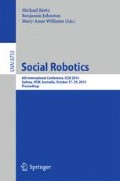Abstract
This paper reports the results from two experiments, conducted in Japan and Australia, to examine people’s perception and trust towards an android robot. Experimental results show that, in contrast to popular belief, Australian participants perceived the robot more positive than Japanese participants. This is the first study directly comparing human perception of a physically present android robot in two different countries.
Access this chapter
Tax calculation will be finalised at checkout
Purchases are for personal use only
Preview
Unable to display preview. Download preview PDF.
References
Perzanowski, D., Schultz, A.C., Adams, W., Marsh, E., Bugaiska, M.: Building a multimodal human-robot interface. IEEE Intelligent Systems 16(1), 16–21 (2001)
Shibata, T., Wada, K., Tanie, K.: Statistical analysis and comparison of questionnaire results of subjective evaluations of seal robot in Japan and UK. In: Proc. IEEE Int. Conf. Robotics and Automation, pp. 3152–3157 (2003)
Haring, K., Mougenot, C., Watanabe, K.: The influence of robot appearance on assessment. In: Conf. Basic and Applied Human-Robot Interaction Research (2013)
Wainer, J., Feil-Seifer, D., Shell, D., Mataric, M.: The role of physical embodiment in human-robot interaction. In: Proc. IEEE Int Symp. Robot and Human Interactive Communication, pp. 117–122 (2006)
Haring, K., Mougenot, C., Watanabe, K.: Perception of different robot design. In: Int. Conf. Knowledge and Smart Technologies. Special session on “Fluency in Communication Between Human, Machine, and Environment” (2013)
Haring, K., Matsumoto, Y., Watanabe, K.: Perception and trust towards a lifelike android robot in Japan. Springer Science+Business Media Dordrecht (in press, 2014)
Remland, M.S., Jones, T.S., Brinkman, H.: Proxemic and haptic behavior in three european countries. J. Nonverbal Behavior 15, 215–232 (1991)
Jack, R., Blais, C., Scheepers, C., Schyns, P., Caldara, R.: Cultural confusions show that facial expressions are not universal. Current Biology 19, 1–6 (2009)
Asimov, I.: The Machine and the Robot. Science Fiction: Contemporary Mythology (1978)
Imanishi, K.: A Japanese view of nature: the world of living things. Psychology Press (2002)
MacDorman, K.F., Vasudevan, S.K., Ho, C.C.: Does Japan really have robot mania? comparing attitudes by implicit and explicit measures. AI & Society 23(4), 485–510 (2009)
Haring, K., Mougenot, C., Ono, F., Watanabe, K.: Cultural differences in perception and attitude towards robots. In: Int. Conf. Kansei Engineering and Emotional Research (2012)
Wang, L., Rau, P.P., Evers, V., Robinson, B.K., Hinds, P.: When in Rome: the role of culture & context in adherence to robot recommendations. In: Proc. ACM/IEEE Int. Conf. Human-Robot Interaction, pp. 359–366 (2010)
Trovato, G., Zecca, M., Sessa, S., Jamone, L., Ham, J., Hashimoto, K., Takanishi, A.: Cross-cultural study on human-robot greeting interaction: acceptance and discomfort by Egyptians and Japanese. J. Behavioral Robotics 4(2), 83–93 (2013)
Salem, M., Ziadee, M., Sakr, M.: Marhaba, how I help you?: effects of politeness and culture on robot acceptance and anthropomorphization. In: Proc. ACM/IEEE Int. Conf. Human-Robot Interaction, pp. 74–81 (2014)
Li, D., Rau, P.P., Li, Y.: A cross-cultural study: effect of robot appearance and task. Int. J. Social Robotics 2(2), 175–186 (2010)
Shahid, S., Krahmer, E., Swerts, M., Mubin, O.: Who is more expressive during child-robot interaction: Pakistani or Dutch children? In: Proc. ACM/IEEE Int. Conf. Human-Robot Interaction, pp. 247–248 (2011)
Bartneck, C., Nomura, T., Kanda, T., Suzuki, T., Kennsuke, K.: A cross-cultural study on attitudes towards robots. In: HCI International (2005)
Walters, M., Dautenhahn, K., Koay, K.L., Kaouri, C., Woods, S.N., Nehaniv, C.L., te Boekhorst, R., Lee, D., Werry, I.: The influence of subjects’ personality traits on predicting comfortable human-robot approach distances’. In: Proc. Cog. Sci., Workshop: Toward Social Mechanisms of Android Science, pp. 29–37 (2005)
Takayama, L., Pantofaru, C.: Influences on proxemic behaviors in human-robot interaction. In: Proc. IEEE/RSJ Int. Conf. Intelligent Robots and Systems, pp. 5495–5502 (2009)
Berg, J., Dickhaut, J., McCabe, K.: Trust, reciprocity, and social history. Games Econ. Behav. 10(1), 122–142 (1995)
Hosokawa, T., Ohyama, M.: Reliability and validity of a Japanese version of the short-form eysenck personality questionnaire-revised. Psychological Reports 72(3), 823–832 (1993)
Bartneck, C., Kulic, D., Croft, E., Zoghbi, S.: Measurement instruments for the anthropomorphism, animacy, likeability, perceived intelligence, and perceived safety of robots. Int. J. Social Robotics 1, 71–81 (2009)
Mori, M.: Bukimi no tani [The uncanny valley]. Energy 7(4), 33–35 (1970)
Swope, K., Amd, P.M., Schmitt, J.C., Shupp, R.: Personality preferences in laboratory economics experiments. J. Socio. Econ. 37(3), 998–1009 (2008)
Author information
Authors and Affiliations
Editor information
Editors and Affiliations
Rights and permissions
Copyright information
© 2014 Springer International Publishing Switzerland
About this paper
Cite this paper
Haring, K.S., Silvera-Tawil, D., Matsumoto, Y., Velonaki, M., Watanabe, K. (2014). Perception of an Android Robot in Japan and Australia: A Cross-Cultural Comparison. In: Beetz, M., Johnston, B., Williams, MA. (eds) Social Robotics. ICSR 2014. Lecture Notes in Computer Science(), vol 8755. Springer, Cham. https://doi.org/10.1007/978-3-319-11973-1_17
Download citation
DOI: https://doi.org/10.1007/978-3-319-11973-1_17
Publisher Name: Springer, Cham
Print ISBN: 978-3-319-11972-4
Online ISBN: 978-3-319-11973-1
eBook Packages: Computer ScienceComputer Science (R0)

